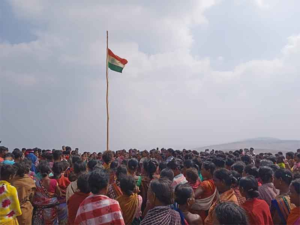The Union finance minister, Nirmala Sitharaman, introduces us to four pillars for whom the 2024–25 interim budget is designed: the poor, women, youth and farmers.
However, the budgetary allocations do not reflect this commitment.
For instance, the expenditure on the Mahatma Gandhi National Rural Employment Guarantee Act scheme (MGNREGA), which was ₹90,806 crore in 2022–23, is down to an allocation of ₹86,000 crore.
The allocation for Mission Shakti, for the empowerment of women, which was ₹3,144 crore in the previous year’s budget, remains almost the same at ₹3,146 crore, which is actually a huge decline if we factor in inflation.
Food subsidy, which was ₹2,72,802 crore in 2022–23, is 25 percent less at ₹2,05,250 crore in 2024–25. Similarly, Samagra Shiksha, which was ₹37,453 crore in 2023–24, is almost the same at ₹37,500 crore.
The allocation for Capacity Building and Skill Development in 2024–25 is exactly the same as the previous year at ₹538 crore.
So this is the priority for the four pillars. These facts appear even more stark considering that these pillars are the ruling party’s election targets in the forthcoming general elections.
The Union health budget
While health is a state subject, the National Health Policy, 2017 makes a commitment that at least 2.5 percent of the Gross Domestic Product (GDP) should be allocated to health by the Union and state governments with the former’s share at 40 percent. This should be achieved by 2024–25.
Thus, given the estimated GDP of ₹3,27,72,000 crore, the health allocation of both the Union and states at 2.5 percent should be ₹8,19,000 crore and the contribution of the Union government at 40 percent should have been ₹3,27,718 crore.
The 2024–25 budget for all three departments of health totals ₹94,371 crore, which includes grants to states and Union territories. As per the health policy commitment, there is a shortfall to the extent of 3.5 times in the Union’s allocation to health.
This shows that healthcare is not a priority for this government and the little allocations it makes, for instance via schemes such as Pradhan Mantri Jan Arogya Yojana (PMJAY), medical education, Central Government Health Scheme (CGHS) and various public–private partnerships benefit the private health sector where public resources get transferred to private healthcare through insurance, subsidies, outsourcing, human resources, etc.
Further, from the previous year’s allocation of ₹92,803 crore, the increase in the health budget is a mere 1.6 percent, which does not even compensate for the inflation of 5–6 percent.
Then again, from the ₹94,371 crore health budget, ₹50,237 crore or 53 percent has been transferred as grants to states and Union territories and this amount gets reflected in state and Union territory accounts.
So, on a net basis, the Union’s own health budget is ₹45,467 crore or only 0.95 percent of the total budget. If we include grants, it constitutes 1.98 percent of the budget or 0.29 percent of the GDP.
From the Union’s own budget, allocations are mainly for All India Institute of Medical Sciences, Delhi and other Union government hospitals, the National Institute of Mental Health and Neuro-Sciences, the National HIV-AIDS and sexually transmitted disease control programme, CGHS and the Union’s establishment.
Interestingly, CGHS, which is a social security benefit for serving and retired Union government employees, judiciary and members of Parliament, is a whopping ₹6,100 crore and is surprisingly included in the Union health ministry’s budget.
The CGHS spending of ₹6,100 crore in 2024–25 is a good example of discrimination in access to healthcare benefits from public resources. Privileged employees and parliamentarians get benefits of ₹16,052 per capita in sharp contrast to the general health budget for common citizens, which is estimated at a mere ₹2,400 per capita nationally.
The grants given by the Union are mainly for the various schemes under the National Health Mission which is ₹33,167 crore and for Union schemes such as PMJAY (₹7,500 crore), HIV-AIDS (₹3,049 crore), human resources for health and medical education (₹5,016 crore), and Ayushman Bharat Health Infrastructure Mission (₹4,108 crore).
In addition to the above, in 2023–24, state governments together budgeted ₹323,934 crore or ₹2,281 per capita, including grants from the Union, for healthcare.
So clearly state governments do spend much more proportionately than the Union government but even state health budgets are far short of the required 60 percent of 2.5 percent of the GDP as mandated by the National Health Policy.
To conclude, the overall and health budget of 2024–25 does not offer anything significantly different from what has been committed in previous budgets.
Though the Union finance minister in her speech did mention upscaling of government hospitals to medical colleges, maternal and child health, immunisation, anganwadi and nutrition programmes, there is no evidence of these having been provided in the budget document.
While presenting the Union Budget 2024-25, Union finance minister Nirmala Sitharaman claimed that over the last 10 years the BJP has ensured social inclusivity and growth for every strata through its commitment to alleviating social and financial vulnerability. Yet. the nominal increase in budgetary allocation for welfare programmes challenge this notion of ‘sabka sath, sabka vikas’.
Union government’s National Social Assistance Programme (NSAP), is one such critical scheme that provides non-contributory income security to the elderly, women and persons with disabilities in the below poverty line (BPL) category. The minimal allocations made to NSAP in today’s budget are both unsurprising and consistent with a decade-long pattern characterised by poor implementation, and restricted funding. This trend indicates the government’s reluctance to meaningfully address the issues of social security and economic protection for vulnerable and marginalised populations.
The budget for NSAP increased by Rs 16 crore, from Rs. 9636 crore (BE) in FY 2023-24 to Rs. 9652 crore in the current budget. While it looks like a marginal increase, however, this is a decline in real terms when indexed to inflation. As a percentage share of the total budget outlay, the allocation to NSAP has steadily decreased in the last decade, reducing from 0.58% in FY 2014-15 to just 0.20% in FY 2024-25.
This decrease is notable, especially considering the expansion of coverage under the three primary sub-schemes of NSAP has increased from 2.12 crore individuals to 2.97 crore individuals during the same period.
For several other social sectors, the revised budgetary estimates show that even the targets from past budget year have not been met in the current financial year. The government was supposed to spend Rs 1,16,417 crore on education, but actually ended up spending Rs 1,08,878 crore.
Likewise, as reported by the Indian Express, “Similar cuts can be seen now in the budgetary allocation for the core schemes for marginalised sections such as SCs, STs, and minorities. For instance, the Revised Estimates (RE) for the Umbrella Scheme for Development of Schedule Castes are Rs 6,780 crore against the Budget Estimates (BE) of Rs 9,409 crore. For STs, the RE is Rs 3,286 crore against a BE of Rs 4,295 crore. For minorities, the fall has been the sharpest. From a BE of Rs 610 crore in FY24 to an RE of Rs 555 crore.”
While unemployment is a very serious problem and several initiatives for improving employment prospects are needed, the budget of the Ministry of Labour and Employment has fallen by half over the past 3 years in nominal terms; in real terms, after providing for inflation, the reduction would be still more. In 2021-22 the actual expenditure of this Ministry was Rs 24,033 crore. This was reduced to Rs 16,893 crore in the 2022-23 Budget Estimate (BE); got further reduced to Rs 13,221 crore in the 2023-24 BE; and in the budget for 2024-25 this has been further cut Rs 12,531 crore.
Calling out the Modi government for its last budget before general elections, Samyukta Kisan Morcha, a collective of farmers’ organisations across the country, said that the budget has brought back the repealed farm laws into action through post-harvest public private partnership policy announced by finance minister Nirmala Sitharaman.
The morcha leaders said that the farmers will not tolerate this betrayal by the Union government and burn the copies of budget on February 3 across the country.
In a statement, the morcha said that as far as agriculture is concerned, the proposal in the budget to “promote private and public investment in post-harvest activities including aggregation, modern storage, efficient supply chains, primary and secondary processing and marketing and branding” is nothing but handing over the agriculture sector in a platter to the corporate houses- both domestic and foreign.
It added, “Not opening the agriculture to foreign and Indian monopoly capital for profiteering has been the policy of the state of India since independence. It helped to ensure self-reliance and food security of the country. Instead of strengthening the public sector, cooperatives and the MSMEs, allowing corporate monopoly houses to take over post-harvesting operations is a policy change and that amounts to the back entry of the three black Farm Acts that Modi Government was forced to repeal due to the pressure of historical farmers’ struggle at the Delhi borders.”
Ashok Dhawale, President, All India Kisan Sabha, stated, “The allocation for fertiliser subsidy in 2024-25 is Rs 87,339 crore less than the actual expenditure in 2022-23. The allocation for food subsidy is Rs 67,552 crore less than the actual expenditure in 2022-23. The anti-farmer attitude of the Modi government is seen in the fact that, year after year, there are budgetary cuts in allocations to key areas such as fertiliser and food subsidies, as well as for important schemes such as MGNREGA. This insensitivity in the wake of the widespread crisis exposes its apathy to the plight of the poor.”
Allocation of resources for women and children, and for Scheduled Castes and Tribes, has also been cut drastically. There has been no allocation to ensure that the long-standing demand of the farmers for ensuring Minimum Support Prices as per the C2+50% becomes a reality.
(Condensed from articles by: Ravi Duggal, “Does the Interim Budget for 2024–25 Offer Anything Beyond an Election Pitch?”, The Leaflet; “Budget Brings Back Farm Laws Through Post-harvest PPP Model”, Newsclick; Bharat Dogra, “Union Budgetary Allocation For Labour Welfare Schemes Showing A Declining Trend”; Deepanshu Mohan, “Interim Union Budget Follows Tradition of Modi Government’s Apathy Towards Most Vulnerable”, The Wire; Asmi Sharma, “Budget 2024: How the Modi Government Has Neglected Social Security Pensions Once Again”, The Wire.)




